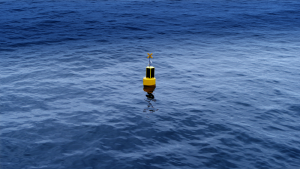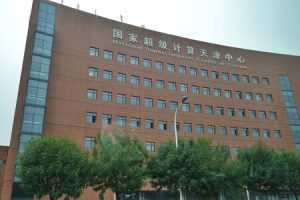-The initiative was promoted by the Compañía Minera del Pacífico, together with the Chilean company “Acústica Marina”, an applied science venture led by women.
-The main objective is to determine, monitor and protect the fauna in the area, mapping underwater noise, incorporating new technologies for the sustainability of the industry and the environment.
-This is the first port-mining initiative worldwide, which has an acoustic immersion room for Scientific and Educational use.
In February of this year, the Compañía Minera del Pacífico (CMP), in the context of its Puerto Cruz Grande project, together with the Valdivian technology company “Acústica Marina” installed the first two “Hydroacoustic Buoys” in the Chungungo area. , Coquimbo region. This with the aim of monitoring and mapping underwater noise to safeguard marine fauna.
This important milestone both nationally and internationally took place last Wednesday, February 22, where the inauguration ceremony and the launch of this innovative project were held. The event was attended by authorities, including the mayor of La Higuera (Yerko Galleguillos), Seremi, social leaders, representatives of CMP, Acústica Marina and the community of the area.
This innovative “Made in Chile” initiative is a fundamental part of the Puerto Cruz Grande project of the Pacific Mining Company, where the first two “Hydroacoustic Buoys” were installed in Chungungo, which have the highest technological solutions in R&D. + i, in order to carry out a detailed analysis of marine fauna and vessels through a Monitoring, Control and Surveillance System (hydroacoustic MCV), which will generate alerts in real time focused on the study and conservation of life and marine ecosystems.
This technology was the winner of the first open innovation contest of the Chilean Navy, Desafío Avante 2020. A project led by a team of interdisciplinary professionals led by women, which was initially created to detect illegal activities at sea, but which can also be used by industries or civil society. This innovation is a Dual Tech technology, which is based on the iCorps methodology developed by the National Science Foundation of the United States.
It should be noted that this is the only initiative in Chile that will have an acoustic immersion room for educational use for those who visit the area and scientific-technological knowledge that will record and process sounds in the sea. One of the most relevant benefits is that this is a passive acoustic monitoring system, so it does not generate any type of noise pollution. In addition to using NCRE in each buoy, as it works 100% through energy with solar panels.
Claudia Monreal Deputy Development Manager of CMP, stated that “We are proud and happy to launch this project that has been a great challenge and has involved great work together with various organizations, but especially together with Acústica Marina. This pioneering initiative worldwide is an unparalleled opportunity, aligned with our strategy, where a fundamental pillar is support for communities, local and regional governments in solving problems, where shared and sustainable value is generated as part of our activity. Always committed to the integral development of the towns and communities that are close to our operations.”
 The assembly of the buoys was carried out in the last quarter of 2022 in the city of Valdivia, where the offices of Acústica Marina are located, to be later transferred to the commune of La Higuera, in the Cruz Grande area. This is the first port-mining initiative worldwide. For the next month it is expected to install 2 more buoys, with the objective that by 2024 there will be a total of 10, in various areas of the Chungungo coast where in the future it is expected to establish a monitoring network at the national level.
The assembly of the buoys was carried out in the last quarter of 2022 in the city of Valdivia, where the offices of Acústica Marina are located, to be later transferred to the commune of La Higuera, in the Cruz Grande area. This is the first port-mining initiative worldwide. For the next month it is expected to install 2 more buoys, with the objective that by 2024 there will be a total of 10, in various areas of the Chungungo coast where in the future it is expected to establish a monitoring network at the national level.
Marcela Ruiz, Director of Marine Acoustics, points out: “It has been a long but very rewarding job together with CMP. We highly appreciate the fact that you have trusted this initiative, which is also technology developed by a 100% Chilean transdisciplinary team, since our work is focused on providing technological solutions for care and sustainable mitigation measures, both for the ocean and for the rich fauna of our coasts, this from the point of view of the triple impact, where economic, social and environmental value is generated, in the decade of ocean sciences for sustainable development”.
Two first buoys in Chungungo
This great milestone began with the installation of the first two buoys, where the official launch of the project took place with an event held on Wednesday, February 22, which was attended by local authorities and residents, in which they discussed the process and how important this port-mining project is, and the sustainable actions that CMP has developed, day by day, which are mostly initiatives that have been led by women. This strategic alliance has as a common objective sustainability, the protection of the sea and its diverse ecosystems.
Rodrigo Peñaranda Rear Admiral of the Chilean Navy and Director of Program, Research and Development comments “I find it fantastic what Acústica Marina is doing in collaboration with the navy, this challenge started in 2020 and coming to see them today being able to develop their product and obviously supporting the sustainability of the oceans, I find it a very important initiative. It What I like about what Acústica Marina is doing is that it is making a proposal that is very innovative about how things can be done in different ways, but also incorporating technologies, supporting science and with a focus on sustainability, not only oceans, but also the sustainable development goals. The initiative itself is good for the development of any project that in one way or another what they seek to do is take care of the maritime areas of Chile”.
Like Carlos Flores, Deputy Mayor of La Higuera who also referred to the incorporation of buoys in the coastal area of Chungungo, “For at least 30 years the scientific community has been studying these issues, installing two buoys of this nature here in our commune, this has a lot to do with development, we have undertaken with an interesting vision of the future of the efforts of the municipality Both the mayor and the different municipal councils that have been working on this. We can be satisfied with how we have approached the local development process”.
Another important aspect of the Puerto Cruz Grande (PCG) project is the inclusion of the social and economic dimension of sustainability. Which means that it not only consists of installing buoys, but also involves supporting and inviting tourism. In addition, CMP is constantly conducting various workshops and training for the community. There will also be an acoustic room, where tourists will be able to listen to the sounds emitted by the whales. In addition, data will be made available to the scientific community at a national and global level, making the area an important pole of attraction in the region. from Coquimbo.
Raul Julio, President of the Totoralillo Norte Artisanal Fishermen Union stated, “Everything that is a scientific advance is good because that way we are going to take care of the environment and the ecosystem of the marine fauna, it is a good initiative that the private company has placed these buoys in the sea, so that people who do not know the marine ecosystem knows that there is an important concern of the company to conserve and preserve the marine fauna of the sector”.
This CMP initiative seeks to contribute to the United Nations Sustainable Development Goals for the year 2030 (SDG), covering 8 of the 17 in total: No. 5 (Equality
of Gender), No. 9 (Industry, Innovation and Infrastructure), No. 10 (Reduction of inequalities), No. 12 (Responsible Production and Consumption), No. 13 (Climate Action), No. 14 (Underwater Life) , No. 16 (Peace, Justice and Solid Institutions), and No. 17 (Partnerships to achieve the objectives). This set of global goals seeks to eradicate poverty, protect the planet and ensure prosperity for all as part of a new sustainable development agenda.













